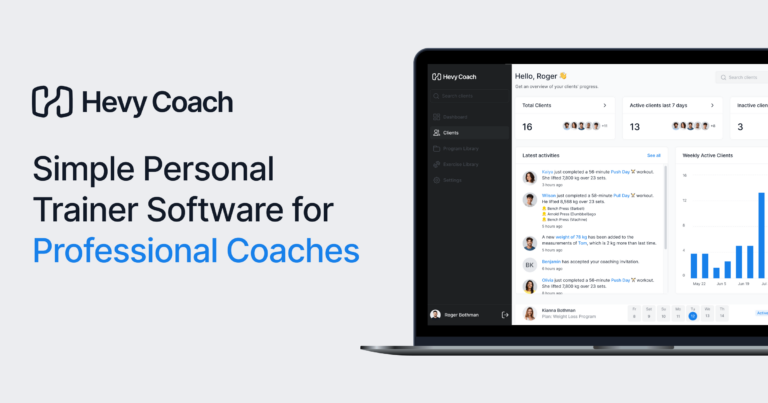At first glance, personal trainers have it easy because they earn a living doing what they love: coaching others.
However, despite the ‘simplicity,’ being a successful personal trainer is quite challenging. A personal trainer needs to understand marketing, human psychology, good business strategies, and, of course, fitness.
To that end, we’ve put together this guide to outline some crucial lessons that will help you guide your clients toward achieving their fitness goals.
Personal Trainer Tips for All Clients
1. Set the Right Goals
Most people don’t know what to expect and often embark on their fitness journey with vague goals like:
- Put on size
- Lose weight
- Get healthy
Your job as a certified personal trainer is to help your clients set smart goals you can track together. For example, you can help clients set long-term goals that keep them engaged and break them down into weekly or monthly objectives.
A person looking to lose weight might set the following goal:
“Lose 30 lbs of fat in the next six months.”
The goal is specific, measurable, attainable, and time-bound. It is much more precise than simply ‘losing weight,’ and it can be broken down into weekly and monthly mini-goals.

Try Hevy Coach
Intuitive personal trainer software, with a world class experience for your clients.
30 day free trial, no credit card required
2. Seek First to Understand
You’re a fitness professional with lots of experience and knowledge, eager to explain what your client needs to do to reach their goals.
Before doing that, slow down, take a deep breath, and listen to your client. Doing so is crucial for understanding what drives them, learning about their struggles, and coming up with an effective way to coach them.
For instance, let’s say that a client’s biggest struggle is staying motivated. In such a case, you can emphasize tactics for keeping them more engaged:
- More frequent assessments to help them see what progress they are making
- More frequent changes to their workouts to keep things fresh
- Putting together fitness challenges
- Leverage a coaching platform (such as Hevy Coach) to track their progress and help them get a respectable workout streak
- Message clients from time to time and let them know they can reach out with questions or concerns
In addition to serving clients better, striving first to understand is an excellent way to build relationships.
3. Put Together a Personalized Workout Plan
A personalized workout plan is one of the most effective ways to show clients you care and make them feel special.

Every personal trainer can scribble a ‘workout plan’ on a piece of paper, hand it to a client, and check in every 15 to 20 minutes to see how things are going.
However, being a good personal trainer is about considering your client’s goals, preferences, injury history, schedule, and current abilities to create a great workout plan. You must also be attentive and listen to client feedback to ensure the training program works for them.
Make your client feel special by showing that you care, and you will build a successful personal training business.
Personal Trainer Tips When Coaching Beginners
Coaching gym newbies can be a bittersweet experience. On the one hand, you have a clean slate, and you get to teach the person all the fundamental things they need for success:
- Proper exercise form
- Navigating a training facility
- Gym etiquette
- How to structure each workout?
- The importance of warming up
- How to select the appropriate load?
- How hard to train?
And many other things.
Unfortunately, you must also work extra hard to retain such clients and keep them invested because most newbies haven’t established any fitness habits. To that end, here are a few personal trainer tips when coaching beginners:
1. Start Small
One mistake fitness professionals (especially new personal trainers) make with newbie clients is pushing them hard right from the start. Doing so often leads to excessive muscle soreness and fatigue, making it challenging for beginners to keep up.
As a result, folks are more likely to give up and conclude that fitness isn’t for them.
Smart personal trainers understand that beginners need time to get used to working out. So, instead of prescribing a demanding workout plan, a good trainer might start their newbie clients on less intense, 20 or 30-minute sessions.
Doing so is an excellent way for clients to see progress early on and enjoy the process instead of dreading each upcoming workout.
2. Emphasize Proper Form
Every personal trainer knows proper form is essential for a safe and effective workout program. However, not every coach focuses on technique as much as they should.
The way many trainers work is simple. Sign a new client, do an initial assessment, teach proper form on a few exercises, and move on from there.
While that is a solid strategy early on, you must re-visit workout technique numerous times until you can be sure that your client:
- Genuinely understands how to perform an exercise
- Learns to self-correct should their form break down

Doing so is necessary because movements are difficult to master, and there are often multiple things to remember. Even if clients have enough theoretical knowledge of a specific exercise, they may lack the experience to perform it correctly.
For example, you could teach a client how to perform the barbell back squat within a couple of sessions. However, as they get fatigued and start using more weight, their form might change, which is why you must return to the basics every so often.
3. Be a Fountain of Knowledge
In addition to guiding people in their training, you should educate them on proper nutrition and recovery. Doing so makes them more informed and capable of making better decisions instead of relying on you for the smallest things.
For example, let’s say that a client hires you to help them lose weight. You could put together the best workout plan for fat loss, but they will fail to progress unless they also change their eating.
So, as a coach, you should educate the person on the following:
- What a calorie deficit is, and why it is essential?
- How to calculate calorie needs and track energy intake?
- What is protein, and why should they eat more of it?
- How sleep affects your client’s outcomes?
Don’t overwhelm your client but teach them something new every time you train them and share resources they can check out: books, articles, podcasts, Youtube channels, etc.
4. Set Realistic Expectations
Most beginners don’t know what to expect from fitness and often have unreasonable expectations, which makes them prone to scams and gimmicks.
As a personal trainer, one of your first tasks is to sit down with each client and explain what they can expect to achieve.
For example, if you’re working with an obese client, explain that losing most of the excess weight will likely take longer than a year. Discuss why traditional diets don’t work and why borderline starvation isn’t a sustainable long-term strategy.
Setting the right expectations can often feel like you’re being a downer, but it is a necessary step to educate your clients and teach them to recognize scammers.
Personal Training Tips to Help Clients Lose Weight
Statistics show that obesity is an ever-growing problem in our society, which means the need for weight loss experts who grasp exercise science is enormous (1).
One effective way to build a reputation in the fitness industry and help people lead a healthy lifestyle is to focus on weight loss.
With that in mind, helping new clients achieve weight loss success is about more than writing good workout plans. Here are a few pieces of advice:

Try Hevy Coach
Intuitive personal trainer software, with a world class experience for your clients.
30 day free trial, no credit card required
1. The Calorie Deficit
Every fitness professional knows a fundamental truth:
Creating a calorie deficit is a crucial piece in the fat loss equation (2). Without it, no amount of training, clean eating, or taking fat burners will lead people to their goals.
In addition to helping clients calculate their calorie needs and track their food intake, you must also explain the goal. Too many people resort to starvation because they think anything less will not bring results.
Teach people that a moderate deficit resulting in weight loss of 0.5 to 1 percent per week is much more sustainable in the long run, especially for people who need to lose a lot of weight (3).
2. Adequate Protein Intake
In addition to a moderate deficit, consuming enough protein supports fat loss by helping people retain more lean tissue and feel fuller throughout the day.
Encourage your clients to consume up to a gram of protein per pound of body weight through meat, fish, eggs, dairy, nuts, seeds, and other protein-rich foods.
3. Strength Training
You don’t need to be a NASM-certified personal trainer to create an effective workout plan, but you must include some strength training in your client’s routine.

Weight training provides the necessary stimulus the body needs to hold onto more lean tissue while losing fat. Without it, clients are more likely to lose muscle alongside fat, ending up in a ‘skinny fat’ state, where they appear thin but lack muscle definition (4).
The amount of strength training one would have to do in such a situation isn’t huge. As few as three weekly sessions of 30 to 45 minutes can be highly beneficial and allow clients to lose fat more effectively.
4. Balancing Strength and Cardio Training
On the note of training, you must balance strength and cardio training to keep your clients on track and away from overtraining.
Most people new to weight loss focus on cardio, thinking it would lead to better results, but that isn’t necessarily true. The primary purpose of cardio is to help people expend some calories, thus achieving the necessary deficit more easily.
However, cardio alone doesn’t provide a strong enough muscle stimulus and cannot protect against lean tissue loss during caloric restriction.
Because of that, if you prescribe cardio, keep it reasonable (5). Advise clients to do cardio on their days off weight training or have them do cardio at least six hours before or after lifting weights.
If neither option works, prioritize strength training and include some cardio at the end of training sessions.
5. Tracking Progress
Beyond the initial personal trainer assessment, you should regularly track your client’s progress. Doing so is necessary for two reasons:
- To see if they are moving in the right direction
- To show them what progress they’ve made and keep them motivated
There are a few ways to track a client’s weight loss progress:
- Have them weigh themselves on an empty stomach at least four times per week, preferably in the morning. Calculate the average and compare.
- Use a tape measure for circumferences. Taking regular measurements of the chest, arms, waist, hips, and thighs provides additional data that helps you determine if they are making good progress.
- Have your clients take progress photos every two to four weeks. Like weigh-ins, they should take pictures in the morning and on an empty stomach.
- Track their training to see how things are moving in the gym. Hevy Coach is an excellent platform for assigning workouts to your clients, tracking their performance over time, providing guidance, etc.
Selling Tips For Personal Trainers
1. Identify Your Niche
The fitness industry is full of personal trainers looking to make a name for themselves. One way to stand out is to identify a specific niche and become an expert.
Focusing on a group of people (e.g., men in their fifties and sixties) allows you to narrow down your efforts and learn about your clients’ specific struggles. In addition, doing so makes it easier to market your services and produce the correct type of content to help people.
Here are a few questions to help you identify your ideal client:
- Who is that person?
- Where do they hang out online?
- What challenges are they facing?
- What goals would they like to achieve?
- What is stopping them from getting results?
- How can you help them?
You can learn more about the topic in our guide on getting more clients as a personal trainer.
2. Network
Building relationships with other fitness professionals is an excellent way to get your name out there, get more opportunities, and grow your own business. You should reach out to trainers locally and online.
Local training facilities can be an excellent place to meet other trainers, build relationships, and even land some clients. Be genuine because nobody likes a salesperson.

Additionally, reach out to personal trainers online. Here are some ideas:
- Set up collaborations – meet with other professionals and do something together (work out, do a presentation in front of local trainees, etc.)
Content production – reach out to professionals when producing content and ask for a quote you can include in an article, Youtube video, social media post, etc. - Join online communities where trainers get together for discussions
3. Build an Online Presence
Building a presence online is an excellent way to land more clients and possibly even transition to online coaching. There are plenty of ways to go about it. Some avenues worth exploring include:
- Create a website and include three pages: About (share some info about yourself and include a bio), Landing page (where you describe and promote your services), and Contact (explain how and where people can reach you).
- Email list – use a service like Aweber to collect people’s email addresses in exchange for bonuses: PDF files, email courses, etc. Maintain your list’s interest by sharing helpful information regularly. People on your list are likelier to engage with you and potentially hire you as their coach.
- Go on social media – leverage platforms like Instagram and TikTok to share helpful information with people and gain a reputation as an expert. Social media is great for engaging people, answering questions, and reaching prospective clients.
Related article: How to Advertise Myself as a Personal Trainer? (4 Key Areas to Focus On)

Try Hevy Coach
Intuitive personal trainer software, with a world class experience for your clients.
30 day free trial, no credit card required
General Tips on Being a Better Personal Trainer
1. Stay Up-to-Date with New Information
Successful personal trainers understand one fundamental truth:
The fitness industry evolves all the time. People learn new things, trends come and go, and research develops to provide new insights.
Getting your personal training certificate is a significant first step, but it isn’t enough. You must continue expanding your knowledge by staying up-to-date with the latest exercise science and nutrition developments.
For example, subscribe to a monthly journal and learn about new developments. The advantage is that you don’t have to seek out the information yourself, as someone compiles the most important findings for the month with commentary and analysis.
2. Build Relationships and Trust with Clients
Building relationships with prospective clients and those who have hired you should be your priority. Doing so helps establish trust between you and makes the client more likely to continue working with you and refer you to others.
Even if you stop working with a client, it never hurts to keep in touch and continue helping them in some ways if you can.
3. Learn How to Communicate Effectively
Many personal trainers struggle to communicate effectively with their clients, which hinders their growth.
Part of what makes someone a successful trainer is the ability to communicate with people. A trainer should show compassion, empathy, and a deep understanding of their client’s issues.
After all, would you work with someone who barely listens to you and only cares about their point of view? Likely not.
When coaching someone, be present and pay careful attention to your client. Show passion and commitment to your profession by helping your client in small and large ways.
The Best Software to Use as a Personal Trainer
Using the right software can make you a better personal trainer. The right tool makes it easy to provide workout plans, track your client’s progress, adjust on the go, and communicate as often as necessary.
Back in the day, there weren’t tools that could do all of these things, which made it difficult for fitness professionals to stay up-to-date with their clients.
Fortunately, we now have fantastic coaching tools that make all that possible and, more importantly, easy.
Hevy Coach is a platform we’ve been developing since 2022 to help personal trainers and coaches elevate their practice by:
- Keeping all of their communication with clients in one place
- Tracking how the client’s training is going
- Making all the necessary adjustments
The platform connects to the Hevy app, simplifying the entire experience for your clients. Once assigned a program, clients can access it from the app, log their workouts, and all that information is available to you and them in just a few clicks.
Conclusion
Personal training can be a deeply fulfilling career path, especially if you’re the type of person who enjoys helping others and sharing what you know.
Despite popular alternatives like group classes and online coaching, the demand for good personal trainers is still high.
Some of the most important things you need to keep in mind are to create the right expectations for your clients, help them set the right goals, and seek to truly understand their struggles, frustrations, and worries.
When coaching newbies, start with something small and manageable, emphasize proper technique, and teach your clients about proper training, good nutrition, recovery, etc.
Like any profession, becoming a successful personal trainer is about continuous improvement. Prioritize your clients and explore new ways to serve them better.
Check out Hevy Coach if you’re interested in an all-in-one platform to coach clients, track their progress, adjust their training plans, and communicate with them.




